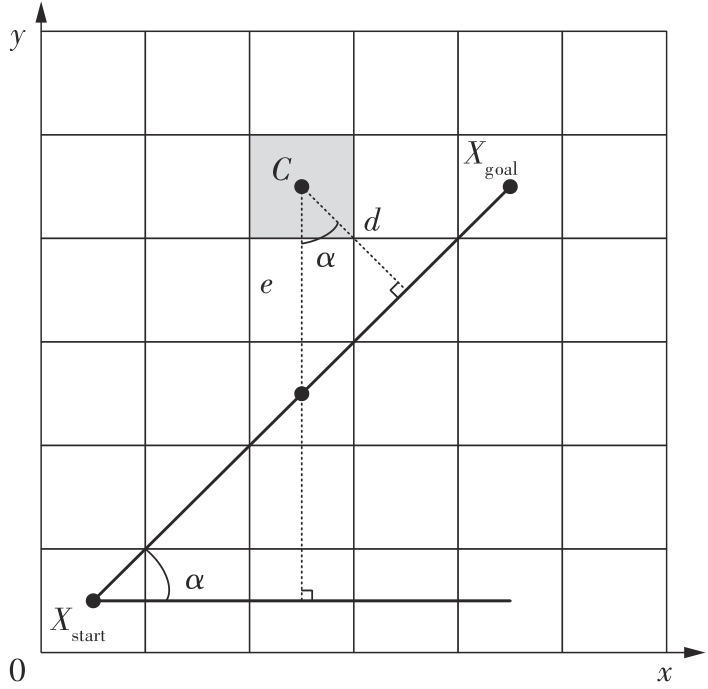| 1 |
全燕鸣, 何一明 . 多机器人任务分配调度的克隆选择算法[J]. 华南理工大学学报(自然科学版), 2021, 49( 5): 102- 110.
|
|
QUAN Yanming, HE Yiming . Research on clonal selection algorithm for multi-robot task allocation and scheduling[J]. Journal of South China University of Technology (Natural Science Edition), 2021, 49( 5): 102- 110.
|
| 2 |
魏武, 韩进, 李艳杰, 等 . 基于双树Quick-RRT *算法的移动机器人路径规划[J]. 华南理工大学学报(自然科学版), 2021, 49( 7): 51- 58.
|
|
WEI Wu, HAN Jin, LI Yanjie, et al . Path planning of mobile robots based on dual-tree Quick-RRT * algorithm [J]. Journal of South China University of Technology (Natural Science Edition), 2021, 49( 7): 51- 58.
|
| 3 |
XU R, YAO S . Research on UGV path planning in tunnel based on the Dijkstra*-PSO* algorithm[C]∥ Proceedings of 2022 the 6th Asian Conference on Artificial Intelligence Technology. Changzhou: IEEE, 2022: 1- 9.
|
| 4 |
GUAN W, WANG K . Autonomous collision avoidance of unmanned surface vehicles based on improved A-star and dynamic window approach algorithms[J]. IEEE Intelligent Transportation Systems Magazine, 2023, 15( 3): 36- 50.
|
| 5 |
DUAN Y, MA G, ZHU J, et al . Research on robot path planning based on A*-weighted JPS algorithm[C]∥ Proceedings of 2021 IEEE International Conference on Recent Advances in Systems Science and Engineering. Shanghai: IEEE, 2021: 1- 7.
|
| 6 |
刘二根, 谭茹涵, 陈艺琳, 等 . 基于改进人工蚁群的智能巡线机器人路径规划[J]. 华东交通大学学报, 2020, 37( 6): 103- 107.
|
|
LIU Ergen, TAN Ruhan, CHEN Yilin, et al . Path planning of intelligent line inspection robot based on artificial ant colony[J]. Journal of East China Jiaotong University, 2020, 37( 6): 103- 107.
|
| 7 |
DUAN C, LI S . Research on mobile robot path planning based on fuzzy artificial potential field algorithm[C]∥ Proceedings of 2023 IEEE International Conference on Control,Electronics and Computer Technology. Jilin: IEEE, 2023: 1408- 1413.
|
| 8 |
XUE Y, HENG Y, LU Q . Robot path planning based on the improved grey wolf optimization algorithm[C]∥ Proceedings of 2022 Power System and Green Energy Conference. Shanghai: IEEE, 2022: 543- 547.
|
| 9 |
陈光友, 余粟 . 改进A *的多机器人双层路径规划算法[J]. 计算机工程与应用, 2023, 59( 11): 312- 319.
|
|
CHEN Guangyou, YU Su . Improved A * multi-robot bilevel path planning algorithm[J]. Computer Engineering and Applications, 2023, 59( 11): 312- 319.
|
| 10 |
史万庆, 黄鸿柳, 蒋林利 . 复杂环境下多机器人协同覆盖搜索路径规划[J]. 电光与控制, 2022, 29( 12): 106- 111.
|
|
SHI Wanqing, HUANG Hongliu, JIANG Linli . Multi-robot path planning for collaborative full coverage search in complex environments[J]. Electronics Optics & Control, 2022, 29( 12): 106- 111.
|
| 11 |
陈南凯, 王耀南, 贾林 . 基于改进生物激励神经网络算法的多移动机器人协同变电站巡检作业[J]. 控制与决策, 2022, 37( 6): 1453- 1459.
|
|
CHEN Nan-kai, WANG Yao-nan, JIA Lin . Multi-mobile robot cooperative inspection operation based on improved biological excitation neural network algorithm in substation[J]. Control and Decision, 2022, 37( 6): 1453- 1459.
|
| 12 |
张丹露, 孙小勇, 傅顺, 等 . 智能仓库中的多机器人协同路径规划方法[J]. 计算机集成制造系统, 2018, 24( 2): 410- 418.
|
|
ZHANG Danlu, SUN Xiaoyong, FU Shun, et al . Cooperative path planning in multi-robots for intelligent warehouse[J]. Computer Integrated Manufacturing Systems, 2018, 24( 2): 410- 418.
|
| 13 |
常路, 单梁, 戴跃伟, 等 . 未知环境下基于改进DWA的多机器人编队控制[J]. 控制与决策, 2022, 37( 10): 2524- 2534.
|
|
CHANG Lu, SHAN Liang, DAI Yue-wei, et al . Multi-robot formation control in unknown environment based on improved DWA[J]. Control and Decision, 2022, 37( 10): 2524- 2534.
|
| 14 |
孔国杰, 冯时, 于会龙, 等 . 无人集群系统协同运动规划技术综述[J]. 兵工学报, 2023, 44( 1): 11- 26.
|
|
KONG Guojie, FENG Shi, YU Huilong, et al . A review on collaborative motion planning of unmanned vehicles[J]. Acta Armamentarii, 2023, 44( 1): 11- 26.
|
| 15 |
陈海, 何开锋, 钱炜祺 . 多无人机协同覆盖路径规划[J]. 航空学报, 2016, 37( 3): 928- 935.
|
|
CHEN Hai, HE Kaifeng, QIAN Weiqi . Cooperative coverage path planning for multiple UAVs[J]. Acta Aeronautica et Astronautica Sinica, 2016, 37( 3): 928- 935.
|
| 16 |
CHEN S, JI J, SU H, et al . Improved A-star method for collision avoidance and path smoothing[C]∥ Proceedings of 2023 IEEE International Conference on Control,Electronics and Computer Technology. Jilin: IEEE, 2023: 32- 35.
|
| 17 |
石为人, 王楷 . 基于Floyd算法的移动机器人最短路径规划研究[J]. 仪器仪表学报, 2009, 30( 10): 2088- 2092.
|
|
SHI Weiren, WANG Kai . Floyd algorithm for the shor-test path planning of mobile robot[J]. Chinese Journal of Scientific Instrument, 2009, 30( 10): 2088- 2092.
|
| 18 |
KONG J, CHENG J . Path planning of mobile robots based on the fusion of an improved A* algorithm and a dynamic window approach[C]∥ Proceedings of 2023 IEEE the 6th Information Technology,Networking,Electronic and Automation Control Conference. Chongqing: IEEE, 2023: 968- 973.
|
| 19 |
李薪颖, 单梁, 常路, 等 . 复杂环境下基于多目标粒子群的DWA路径规划算法[J]. 国防科技大学学报, 2022, 44( 4): 52- 59.
|
|
LI Xinying, SHAN Liang, CHANG Lu, et al . DWA path planning algorithm based on multi-objective particle swarm optimization in complex environment[J]. Journal of National University of Defense Technology, 2022, 44( 4): 52- 59.
|
| 20 |
周波, 钱来, 孟正大, 等 . 基于改进遗传算法工业机器人多路径组合规划[J]. 华中科技大学学报(自然科学版), 2011,39(增刊Ⅱ):9- 12.
|
|
ZHOU Bo, QIAN Lai, MENG Zhengda, et al . Multi-path integration planning of industrial robots based on an improved genetic algorithm[J]. Journal of Huazhong University of Science and Technology(Natural Science Edition), 2011,39(Sup.Ⅱ):9- 12.
|
| 21 |
赵文政, 刘银华, 金隼 . 面向多机器人协调运动规划的层级化任务分配方法[J]. 计算机集成制造系统, 2021, 27( 4): 999- 1007.
|
|
ZHAO Wenzheng, LIU Yinhua, JIN Sun . Hierarchical task assignment algorithm for multi-robot coordinated path planning[J]. Computer Integrated Manufacturing Systems, 2021, 27( 4): 999- 1007.
|



















